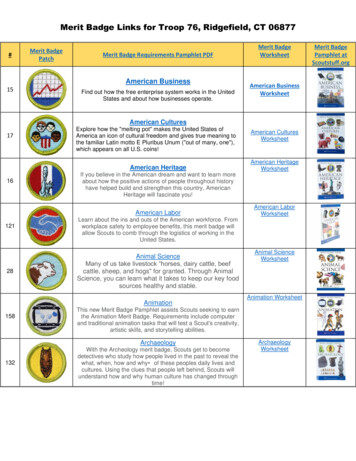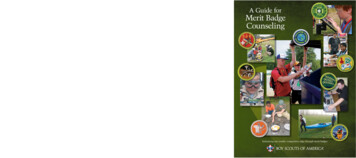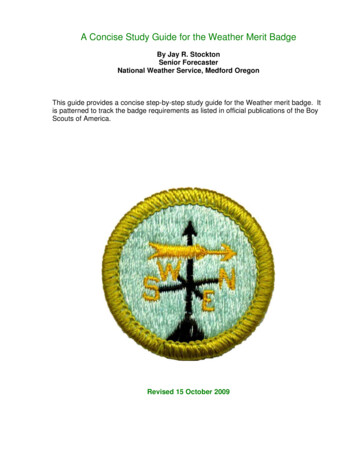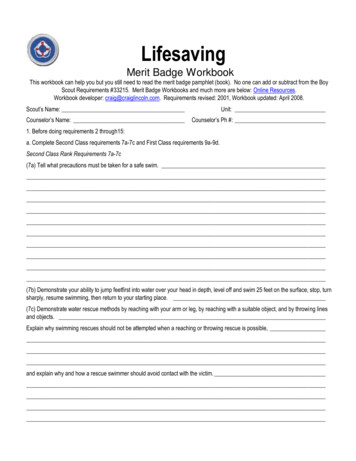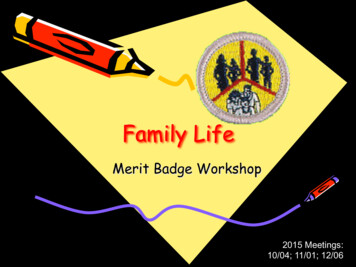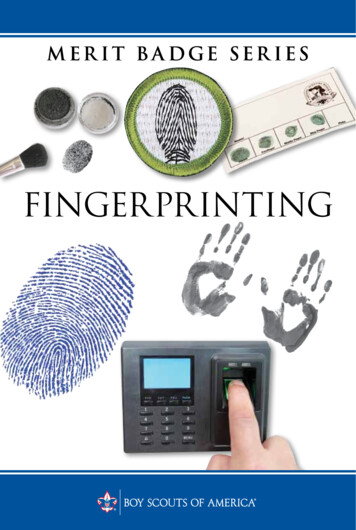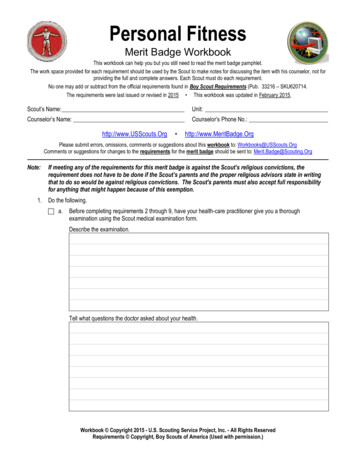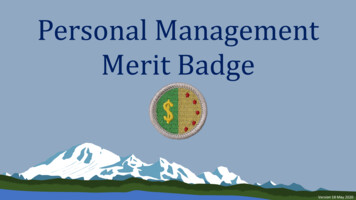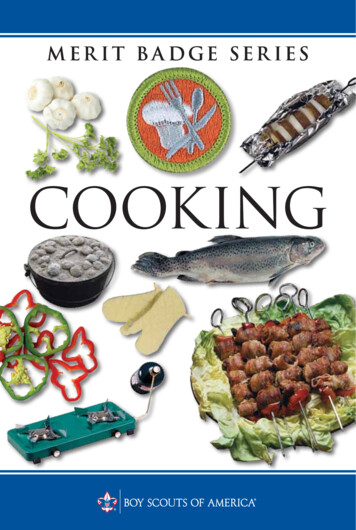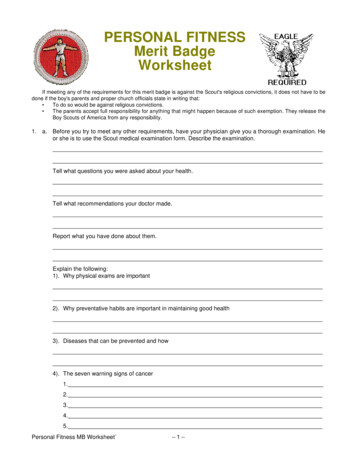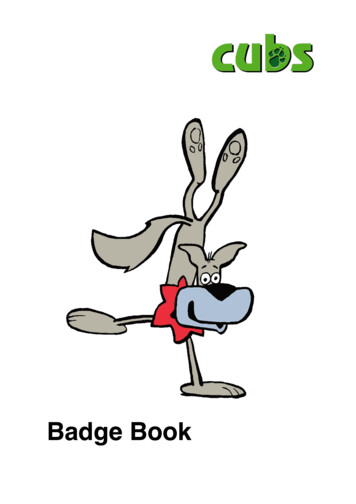
Transcription
Badge Book
There is a range of badges and awards available to young people in the CubScout Section.Core badgesThere are a number of special badges, obtained upon joining or moving on from thePack, or for time spent in the Scouting movement.Challenge awardsGaining a challenge badge involves accomplishing a number of more ambitioustasks within the Pack or community. There are several challenge badges across anumber of themes, from the physical and outdoorsy to challenges dealing with thelocal community or issues connected with the Scouting world.If a Cub gains all six during their time then they earn the highest award available WKH &KLHI 6FRXW¶V 6LOYHU ZDUG We will attempt to meet the requirements of one challenge badge per term withinformation hopefully on the published programme(!).Activity badgesMany of the badges available are activity badges, which allow Cub Scouts to showtheir progress in existing pursuits, but also to try all kinds of new things and formnew interests. Some of these will be covered during our programme but with 33 tochoose from there should be something for everyone!Please feel free to look at the activity badges you could earn on the followingpages. If there are any you would like to try then print out the sheet and have a goat home. If you want help at anytime whilst doing the badge, then talk to a leader.You also need to be aware that badge requirements are constantly refined andupdated and so what is written here is only correct at the time of going to print.Please ensure that we know which ones you are attempting so we can make sureyou have the up-to-the-minute information!We can also provide you with forms for your parents, teachers or coaches to sign toshow you have completed a requirement.2
Position of badges on uniform (Cub Scouts)I promise that I will do my bestTo do my duty to God and to the Queen,To help other peopleAnd to keep the Cub Scout LawCub Scouts always do their bestThink of others before themselvesAnd do a good turn every day3
The Cub Scout MembershipAwardA young person joining the Cub Scout Pack and who has not previously been aBeaver Scout will start work on their Cub Scout Membership Award straightaway.The badge is presented at the Investiture ceremony when the new Cub Scoutmakes their Promise.Requirements1. Area One Know about the Cub Scout Pack(a) Get to know the other Members and Leaders in your Six and Pack.(b) Find out about the ceremonies and traditions in your Pack.(c) Find out about the activities that your Pack does.2. Area Two Know about joining your Pack(a) Know and understand the Cub Scout Promise and Law and the rules inyour Pack.(b) Know and understand the Cub Scout Motto, Sign, Salute and Handshake.(c) Know what to do at your Investiture.(d) Know the meaning of the badges you will receive.(e) Know the history of the family of Scouts and worldwide Scouting.The Promise ChallengeCub Scouts should complete four activities from the following:1. Over a period of time help another Cub during Pack activities; this could be forD QHZ &XE¶V ILUVW IHZ ZHHNV LQ WKH 3DFN RU RQ D UHVLGHQWLDO H[SHULHQFH 2. Over a period of time carry out good turns for some one outside of the Pack.This could be helping a relative with housework or doing some work in the local community.3. Describe an occasion that they found particularly challenging and explain howthey did their best.4. Find out about someone who has done their best.5. Take an active part in the leadership of the Pack.6. Help to run a Pack activity or game.7. Take part in Pack Forums and be a role model for younger Cubs.8. Take an active part in an act of worship, reflection or celebration with other4
&XE 6FRXWV 7KLV FRXOG EH LQ WKH IRUP RI 6W *HRUJH¶V 'D\ FHOHEUDWLRQV 5HPHPEUDQFH 'D\ RU 6FRXWV¶ Own.9. Find out about a faith other than their own. This should include places of worship and a festival or ceremony. If possible a visit to a place of worship shouldbe undertaken or a visit from a religious leader arranged.10. Hold the My Faith Activity Badge.Community ChallengeCub Scouts should complete three of the following:1. Find out about a place of worship (preferably different from their own) in theirlocal community. Find out what happens there and tell other Cub Scouts aboutit. If possible they should visit a place of worship or meet a religious leader.2. Organise a fundraising event for a charity of their choice.3. Over a period of a month take good care of a pet. Make a record of how theyhave cared for their pet, for example, food, exercise, and cleaning/grooming.4. Meet or visit someone who helps their local community, for example, a policeofficer, a fire fighter or lifeboat crewmember. Explain to others what they havelearned and how we can help them to do their job.5. Find out what hazards there could be in the home or Meeting Place or on acampsite. Help other Cub Scouts to be aware of any dangers.6. Learn the following basic First Aid: controlling bleeding, burns and scalds, airway protection and how and when to get help.Fitness ChallengeCub Scouts should complete all of the following:1. Show how they have done their best in a sport or activity over a two-week period. This can be something new or a sport/activity they currently take part in.2. Show how they have improved their physical fitness over a two-week period.This might include examining what they eat and improving their diet, how muchexercise they take, how much sleep they get and explain how they might continue to improve their fitness in the future.3. Try two new sports or physical activities at least once, for example, tennis,dance, basketball or Tai Chi.5
Creative ChallengeCub Scouts should complete three of the following:1. Create and then read or perform a prayer, reading or sketch for a service,about their Promise. This should include why the Promise is important tothem or how they have used the Promise to help other people. This could bedone individually or in a small group.2. Plan and perform a musical performance, play or sketch.3. Create two new games for the Pack.4. Design and make something, for example, a birdhouse, model or kite.5. Create something using information technology, for example, a birthday card,party invitation, or a poster.6. Make a creative presentation about an aspect of Cub Scouting. This could bein the form of a video, photos or posters. It could show the activities they enjoydoing, a Cub camp or be used for recruiting new members.7. Write a poem or short story on a subject of their choice.8. Design and make something using pioneering skills, this could be a raft or ascaled down model of a bridge.9. Take part in a problem solving activity that requires creative thinking. Thiscould be an incident hike or a code breaking activity at camp.Global ChallengeCub Scouts should complete four of the following:1. Find out about the traditions, culture, food, religion and other interesting thingsof a country different from their own.2. Find out about the work of an international charity that helps around the world,for example, OXFAM, UNICEF. Present their findings to the rest of the Pack.3. Find out about an aspect of international Scouting. They could take part in aµ-RLQ ,Q -DPERUHH¶ DFWLYLW\ RU DUUDQJH D YLVLW IURP D -DPERUHH SDUWLFLSDQW 2U they could find out about Scouting in a country of their choice.4. Find out about things that can be recycled or how energy can be saved. Overa period of weeks show how they have recycled or saved energy at home.5. Find out about a global issue such as poverty, conservation or water and sanitation and what they can do to help.6. Find out about a technology of their choice. This could be a personal computer, a car engine, an aircraft or anything similar. They should understand thebasic functions of the technology and how it is used and a brief history. Theyshould then present your findings to the rest of the Pack.6
Outdoor ChallengeCub Scouts should complete all of the following:1. Take part in at least one residential experience (preferably camping) with aminimum of two nights away. The two nights do not need to be consecutive.2. Explain to other Cub Scouts what activity they enjoyed most whilst on the residential experience and what activity they found hardest. This could be in theform of a poster, story, photographs or similar.3. Learn two new skills and use them, for example: tracking, fire lighting or somebasic knots.4. Take part in three new outdoor activities that you have not done before, for example, shelter building, pioneering, archery, skiing, abseiling, a wide game orkite flyingOutdoor Plus ChallengeThe Outdoor Plus Challenge is an optional choice particularly aimed at the olderCub Scout who has completed the Outdoor Challenge.Cub Scouts should complete all of the following:1. Hold the Outdoor Challenge.2. 7DNH DQ DFWLYH SDUW LQ KHOSLQJ WR SODQ RU UXQ WKH 1LJKW¶V ZD\ H[SHULHQFH IRU example, help a less experienced Cub Scout during the event or plan and leadD 6FRXWV¶ 2ZQ RU JDPH 3. Know how to prepare for a one-day expedition to the countryside (e.g. correctclothing, footwear, First Aid kit and food and drink).4. Spend two nights away on a residential experience with other Cub Scouts(these nights should be in addition to Nights Away used for the Outdoor Challenge but do not have to be consecutive).5. Plan and then travel along a route of at least one kilometre on foot or using anymethod of self-propelled transport and navigate using any of the following:Compass, Map, Landmarks, Tracking signs, Taped instructions Or plan andthen use a route using at least two types of public transport. The route shouldnot be one that is familiar to the Cub Scout.7
&KLHI 6FRXW¶V 6LOYHU ZDUGThis badge is the highest award available in the Cub Scout Section. It is gained bycompleting: Promise ChallengeCreative ChallengeCommunity ChallengeFitness ChallengeGlobal ChallengeOutdoor ChallengeIf a Cub Scout has not quite completed the requirements for the top award whenthey move on to the Scout Troop, they may complete them in their first few weeks inthe Scout Troop.8
Air ActivitiesComplete the following:1. Know the dangers involved in visiting an airfield.2. Visit an airfield, air display or air museum.3. Choose three of the following:(a) Make and fly one of the following: a model aeroplane, three different typesof paper glider, a hot-air balloon, or a kite(b) Identify six airlines from their markings(c) Name and identify the main parts of an aeroplane(d) Assemble a plastic scale model aeroplane to a reasonable standard(e) Name and identify the different types of aircraft (powered aeroplanes, airships, gliders etc.)(f) Fly in an aircraft and share their experience with the Pack(g) Explain how different weather conditions can affect air activities(h) Collect and identify six different pictures of aircraft and share them withother Cub ScoutsThe RAF Museum provides resources for this badge on its Cosford and LondonWebsites: RAF Museum London RAF Museum CosfordRaksha holds worksheets for requirements 1 and 3. Please ask.Animal CarerComplete three of the following.1. Visit a zoo or wildlife park. Find out about some of the feeding habits and natural habitats of the animals they see.2. Take care of a pet for three months and know the correct foods to give it. Beable to recognise common illnesses and know how to treat them.3. Help to care for a farm animal and know the correct food to give it. Know howto recognise common illnesses and what special care is needed before andafter the birth of farm animals.4. Keep a record, in pictures, sketches, photographs or tape recordings, of bird,animal and/or insect life in their garden or local area/park.5. Know six different freshwater, seawater or tropical fish and what types of foodsthey eat.9
6. Belong to an animal, bird or wildlife society. Either take part in one of its activities or make progress in any award scheme offered.7. Find out about the dangers in the countryside that threaten wildlife and eithermake a poster, collage or drawing or tell other Cub Scouts about their findings.Pets at Home have published a workbook to help achieve this badge which youcan download from: Pets at Home WorkbookArtistComplete three of the following. One of these activities should be done in the presence of a Leader.1. Draw with pencil, brush, pen or crayon a picture of any imaginary incident,character or scene.2. Design and make a greetings card.3. Make a poster advertising Cub Scouting or a Cub Scout event.4. Make a design and print it on paper or fabric, e.g. using potato or lino cuts.5. Design and make a decorated book cover.6. Draw or paint a picture from still life or a landscape.7. Make a display of photographs on a subject that interests them.8. Make a video on a subject that interests you.9. Design and build a model.10. Visit an art gallery.11. Make a model out of clayAstronomerComplete the following:1.2.3.4.Make a model or draw a simple diagram of the solar system.Explain the difference between a planet and a star.Identify three constellations.Find out about and present some information on the two of the following: Planets, Comets, the Northern Lights, The Sun, Eclipses, Meteorites, Black holes,The Moon, Light years, Space exploration or any other space related subject.5. Observe the Moon, if possible using binoculars or a telescope. Describe someof its features.6. Know how to locate and identify the pole star. Know how explorers used it tonavigate and plot courses.10
Athlete1. Take part in an appropriate warm-up and warm-down routine, led by asuitable person (eg adult, Young Leader or Scout), using all the main musclegroups. For example: skipping, running on the spot, stretching both arms highabove the head and then relaxing down, bending the knees and dropping thehead, rolling the head slowly around, tensing and relaxing the shoulders2. Explain the most appropriate clothing to wear and how to be safe when takingpart in athletic activities.3. Take part in one of these throwing activities:oThrow a tennis or cricket ball, both over arm and under arm, as far youcanoThrow three bean bags into a bucket, increasing the distance eachtimeoThrow a football-sized ball, using a chest push and overhead throw, asfar as you can.4. Take part in two of the following running activities, trying your best:oShuttle run 6 X 10mo50m skip with a ropeo50m sprinto25m sack raceo25m egg and spoon raceo400m run.5. Take part in one of the following team activities:o4 x 100m relayoTeam assault courseoAssisted blindfold race6. 6. Take part in one of the following jumps, going as far or as high as you can:oSargent jumpoStanding jumpoHigh jumpoLong jump11
NotesxThis badge is awarded for participation and putting in your best effort.xFor the high jump, special attention must be given to the nature of the jump,and the landing facilities required. Unless expert tuition and supervision isavailable, you must not attempt the Fosbury Flop.xThe badge could be gained by taking part in a sports day in the Pack or in theDistrict which includes these activitiesFlexibilityEvery individual who undertakes an activity badge should face a similar degree ofchallenge and as a result some requirements may need to be adapted.It is completely acceptable to change some of the requirements of the badges toallow individuals to access the badge (for example where there are special needs,cultural issues, or religious considerations to take into account) and therequirements outlined for activity badges do allow for some flexibility in order toobtain the badge.Athlete PlusGain at least 8 points. Add up the scores from the best four events.NotesFor event three, special attention must be given to the nature of the jump, and thelanding facilities required. Unless expert tuition and supervision is available, youmust not attempt the Fosbury Flop.For event five, the measurements refer to the height of the target when held at fullarms stretch by the participants.Events3 points2 points1 point1 50m Sprint9 seconds10 seconds11 seconds2 Throwing a cricket ball25 metres22 metres18 metres3 High Jump96cm86cm76cm4 Long Jump3 metres2.5 metres2 metres35cm30cm25cm6 Shuttle run 6 x 10 metres18 seconds19 seconds20 seconds7 50 metres Skipping12 seconds13 seconds14 seconds5 minutes6 minutes10 minutes5 Sargent Jump8 1,000 metre runAthlete Plus Event Scores12
For event six, the limits of the run are marked on the ground. Your hand or foot musttouch on or past the mark at the end of the run.Book ReaderComplete the following:1. Make a list of at least six books read or used recently. Name their authors andbe able to tell the Leader or other members of the Pack something about threeof the books. The three books chosen should include at least one fiction andone non-fiction book.2. Understand and know how to care for your books.3. Show that you can use a dictionary, encyclopaedia and an atlas.4. Explain to a Leader how the books in a library are set out and how you wouldfind fiction and non-fiction books.CamperComplete the following:1. With other Cub Scouts, camp under canvas for at least three nights (not necessarily on the same occasion).2. Help pack personal kit for a Cub Scout camp.3. Help to pitch and strike a tent and know how to take care of it.4. At camp, help to prepare, cook, serve and clear away a simple meal, ifpossible out of doors.5. Know how to look after yourself and be safe at camp. Know how to prepare fortent and kit inspection.6. Take part in at least three of the following while at camp:(a)(b)(c)(d)(e)(f)camp fire6FRXWV¶ 2ZQ wide gamejoint activity with other Cub Scouts on site or from a local Groupa good turn for the sitehelp to tidy up the campsite before they leave13
ChefComplete the following:1. Know the basic rules of safety and hygiene in the kitchen and the reasons forthem.2. Discuss with your Leader the advantages and disadvantages of different methods of preparing and cooking food.3. Discuss the importance of a balanced diet.4. Under adult supervision plan, cook, serve and clear away a two-course mealfor at least two people. Discuss their menu with the people you are cooking for.It should include preparing and cooking vegetables.The following dishes are given assuggestions. Main Courses 6KHSKHUG¶V SLH Curry and Rice,Ham salad,Vegetable lasagne.Deserts Fruit crumble, Fresh fruit salad.6. Make scones, small cakes, biscuits or tarts.CollectorComplete the following:1. Make a collection over a period of three months of a number of similar items(e.g. stamps, coins, postcards, fossils).2. Display your collection in an exciting and interesting way.3. Talk about items in your collection that particularly interest you.4. View a collection made by someone else and explain what they like or dislikeDERXW LW¶V SUHVHQWDWLRQ CommunicatorComplete the following:1. Show how to use a public telephone.2. Describe how to make an emergency call, and what you would need to tell the14
3.4.5.6.emergency operator.Receive directions or instructions to do something. Check with the informationprovider that you have understood and then followed the directions or instructions.Arrange for someone that you know to give you a call. Take down the message, making sure that you have all the relevant details.Find out about and show you can use at least three of the following: fax (facsimile) machine, answering machine, mobile phone, email, text messages,pager or voice mail.Complete any three of the following activities:(a) Make a verbal, taped or a newsletter report of a local event either past orpresent.(b) Make and maintain a link with another Cub Scout Pack using tapes,videos, letters, email etc. for an agreed period.(c) Find out how people with a visual or hearing impairment communicate(e.g. Braille, Makaton or British Sign Language). Learn a simple phrase inan alternative form of communication(d) Tell a story about an experience you have shared with your Leaders andother Cub Scouts. Make sure that you communicate clearly and thatthose listening are following the story.(e) Hold a simple conversation in another language.(f) Write and decipher three simple messages using codes, ciphers, invisibleink, or semaphore.(g) Memorise a short message and re-tell it 15 minutes later.(h) Pass a message to someone using amateur radioCyclistComplete the following:1. Own or have regular use of a bicycle of a suitable size and a cycle helmet.2. Be able to mount and dismount properly.3. Understand the need for keeping the bicycle in a roadworthy condition, andhow to do this.4. Be able to clean and oil a bicycle. Show how to pump up the tyres and how tomend a puncture.5. Understand the need for keeping a bicycle locked when leaving it unattended.6. Make a poster to promote road safety to pedestrians or cyclists.7. Understand the need for lights and reflective clothing. Discuss with yourLeader or other Cub Scouts the safety measures necessary for riding in poorconditions.8. Under observation, in a safe place, go for a short ride to show that you can15
ride safely and confidentlyNotesCycle helmets should be worn at all times during cycling activities. Please alsorefer to Policy, Organisation and Rules on cycling .DIYComplete the following:1. Show the safe use of, and how to take care of, tools such as a hammer, a saw,a screwdriver, spanners, pliers, a hand-drill, a glue gun etc.2. Show how to prepare and paint a vertical surface with paintbrushes, roller orpad and show how to clean them.3. Help design and make two items from the following:(a)(b)(c)(d)(e)(f)(g)(h)a nesting box or window boxa box for storing tools, pencils, tapes, etc.a rack for keys, mugs or coatsbook-ends or bookstanda shoe racknotice-board for campletter holdertowel railEmergency AidYoung people should be trained and assessed using the syllabus and resourcesprovided in conjunction with the British Red Cross. These are published on http://www.scouts.org.uk/emergencyaid/ and supporting programme material for the first theestages can be found on Programmes Online.At each stage Leaders should not assume prior knowledge but should cover the fullsyllabus using instruction games and exercises to reinforce the learning.For stages 1 3 ongoing assessment is acceptable.For stages 4 and 5 a more structured assessment at the end of the course is recommended to test knowledge.16
Emergency Aid 1Complete the requirements below.1.2.3.4.Understand and recognise dangers in the house and outside.Know what to do at the scene of an accident.Know how to open an airway.Know how to treat minor cuts, scratches and grazes.NotesThis stage requires 1 to 2 hours activity/learning and should be trained andassessed by an adult or young leader familiar with the resource material.Emergency Aid 2Complete the requirements below.1.2.3.4.5.6.Know what to do at the scene of an accident.Know how to get help from the emergency service.Know how to clear an airway and place in the recovery position.Know how to deal with minor bleeding.Know how to deal with major bleeding.Know how to deal with burns and scalds.NotesThis requires 2 / 3 hours of training/activity and should be trained and assessed byan adult or young leader with First Response or equivalent external qualifications,famil-iar with the resource material.A young person holding a first aid award covering this or a similar syllabus from arecognised First Aid provider (such as the Young Life Savers key stage 2 [8 11yrs] or the Save a Life from the British Red Cross) automatically qualifies for thisstage of the award.Emergency Aid 3Complete the requirements below.1. Know what to do at the scene of an accident.2. Know when and how to contact the Emergency Services.17
3. Be able to respond to the needs of an unconscious patient. Know how to openan airway, give CPR and how to place in the recovery position.4. Know how to deal with major bleeding.5. Know how to deal with burns and scalds.6. Know how to safeguard against the effects of heat. Know how to recogniseand treat heat exhaustion.7. Know how to safeguard against the effects of cold. Know how to recognise andtreat hypothermia.8. Recognise the symptoms of shock and how to treat a casualty.9. Know how to deal with choking.NotesThis stage requires 4 / 5 hours of training and activity and should be trained and assessed by an adult with current experience of First Aid training, who holds a First Response or equivalent external qualification and is familiar with the resource material.A young person holding a first aid award covering this or a similar syllabus from arecognised First Aid provider (such as the Young Life Savers key stage 3)automati-cally qualifies for this stage of the award.EntertainerComplete three of the following1.2.3.4.5.6.7.8.9.10.Help to make up a mime or play and perform it.Perform a puppet play or shadowgraph using puppets, which you have made.Help to plan and make an entertainment recorded on video or audiotape.Sing two songs.Perform some folk or traditional dances.Make a selection of simple rhythm instruments and use them as accompaniments.Tell a story to an audience.Make up and perform a dance to a piece of music of your choice.Help plan and perform a series of magic tricks.Take part in a show, concert or band performance.EquestrianComplete the following:1. Show how to mount and dismount a horse safely.18
2. Show the correct position in the saddle.3. Show how to hold the reins correctly.4. Show how to ride safely in an enclosed area without a leading rein. Thisshould include walking and trotting.5. Show two of the following skills:(a)(b)(c)(d)(e)walking without stirrupswalking on a loose rein and shortening the reinsriding up and down a hill at walking pacecanteringriding over a single pole or very small fence.Global ConservationCub Scout s must carry out these projects as a member of a group of Cub Scoutsand not alone.This group may be a Six or other small group.1. While you are working on this Badge with your group:(a) find some examples showing how people have damaged the environmentand other examples showing how people have conserved the environment(b) find examples of where the Countryside Code is being broken and whathas happened as a result.2. Take part as a group in two projects, such as:(a) clearing a ditch, pond or creek(b) making, setting up and maintaining a bird feeder, bird table, bird nestingbox or bird bath(c) looking after a piece of land or a garden(d) tidying up a piece of wasteland(e) taking part in an anti-litter campaign(f) planting a tree or shrub(g) looking after a compost bin.3. Choose one from the following:(a) make a display to inform others about an animal, bird, plant, fish, etc.which is in danger of extinction(b) RUJDQLVH D µVDYH LW¶ FDPSDLJQ WR HQFRXUDJH RWKHUV WR FRQVHUYH HQHUJ\ e.g. home insulation, fuel efficient engines, etc.(c) take part in or start a recycling scheme, e.g. bottles, cans, waste paper(d) visit a forest, wood or campsite and take part in a project on tree conservation. With expert help, find out how trees can be cared for19
Resourcesco2balance have produced a free on-line resource for Leaders and Young peopleto help achieve this badge. There is also resources available at Resource Pack:OMSCo Global Conservation Activity Pack.Hikes Away 1Complete 1 hike or journey with a purpose as agreed with the Leader. Those takingpart should be dressed and equipped for the prevailing conditions and terrain.Hikes Away 5Complete 5 hike or journeys with a purpose as agreed with the Leader. Those taking part should be dressed and equipped for the prevailing conditions and terrain.Hikes Away 10Complete 10 hikes or journeys with a purpose as agreed with the Leader. Thosetaking part should be dressed and equipped for the prevailing conditions and terrain.NotesReference should be made to the Activity Rules in Chapter 9 of POR and theActivty Permit Scheme.([DPSOHV RI DFWLYLWLHV TXDOLI\LQJ IRU D µ LNH ZD\¶ DUH OLVWHG EHORZ 2WKHU VLPLODU DFtivities could be undertaken.About 3 hours of activity. Examples might be: Follow a towpath trail and discovering how locks work on the local canal. While on camp or pack holiday explore on foot a local town or village. Walk up a hill and enjoy the view.HobbiesComplete the following:1. Know the safety rules relating to the hobby (if applicable).20
2. Show a continuing interest in your chosen hobby, interest or activity for twomonths.3. Show your Leader, or other Cub Scouts, how you pursue their hobby, interestor activity. Show what equipment, materials and background information youhave used.4. Discuss with your Leader how your plan to develop their hobby, interest or skillin the future.Home HelpComplete the following:1. Under adult supervision, cook a simple one course meal2. Lay a table and serve a simple meal. This can be done with requirement number one.3. Wash up afterwards and show how to clean a saucepan or similar cookingutensils, cutlery, glassware, etc. This may include loading and unloading adishwasher.4. Under adult supervision, wash and iron your Group Scarf.5. Sew on a badge or button.6. Keep your room clean and tidy and make your bed for a week.7. Clean two of the following: windows, silver, brass-work, basin or cupboard8. Clean and tidy a living roomHome SafetyComplete the following:1. Know what to do in the event of a burst water pipe, gas leak or electricitypower failure in your home.2. Know what precautions you need to take and what to do if fire breaks out inyou home.3. Be able to identify the common causes of accidents in the home and how theycan be prevented.4. Know what precautions to take to protect your home from crime.5. Know how to make an emergency telephone call, including using mobile telephones, to call the emergency services. Know where the nearest public telephone box is to your house, or where you can make an emergency call shouldtheir phone be out of action.6. Make a list of useful emergency numbers.21
The Nat
Badge Book. 2!! There is a range of badges and awards available to young people in the Cub Scout Section. Core badges There are a number of special badges, obtained upon joining or moving on from the Pack, or
